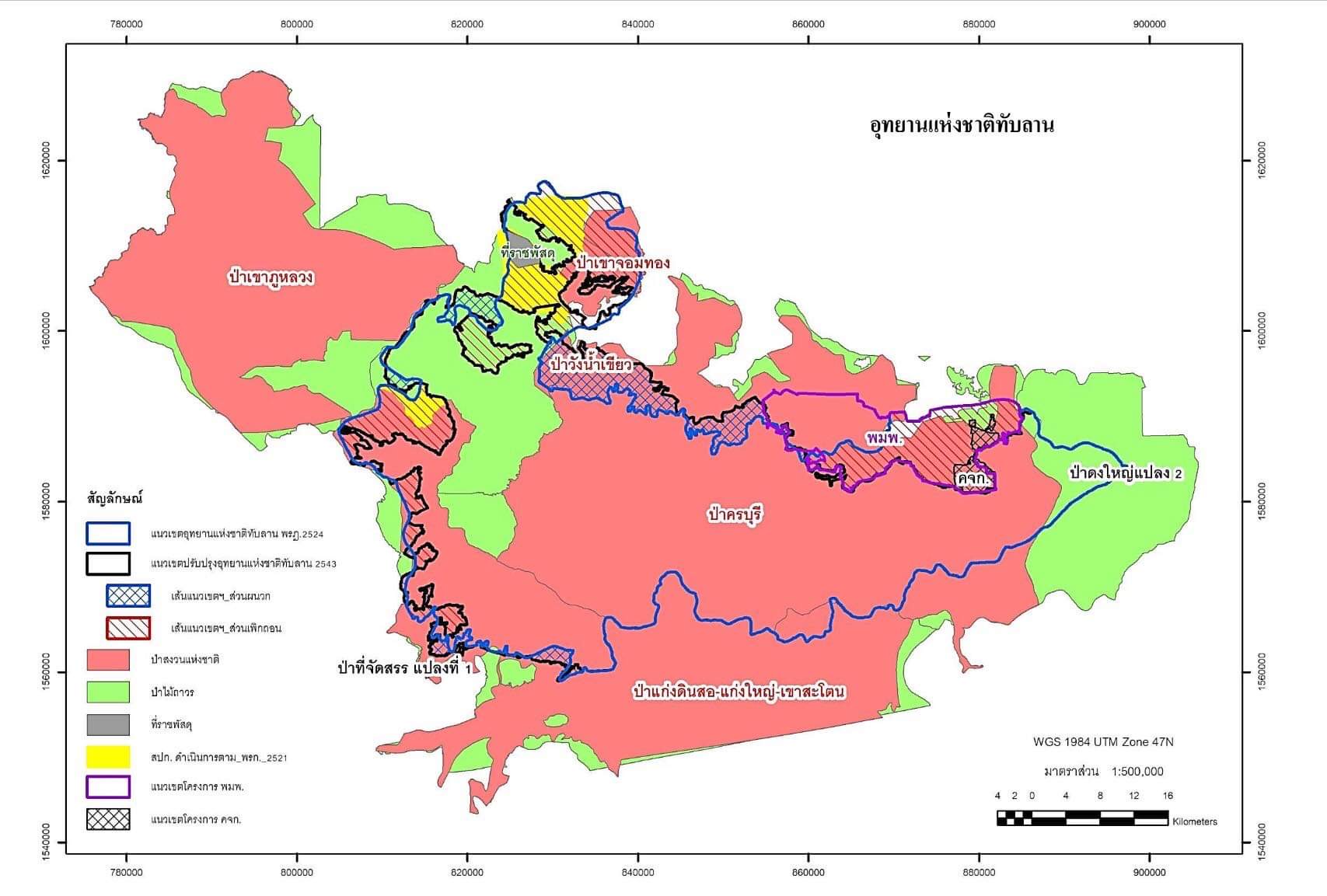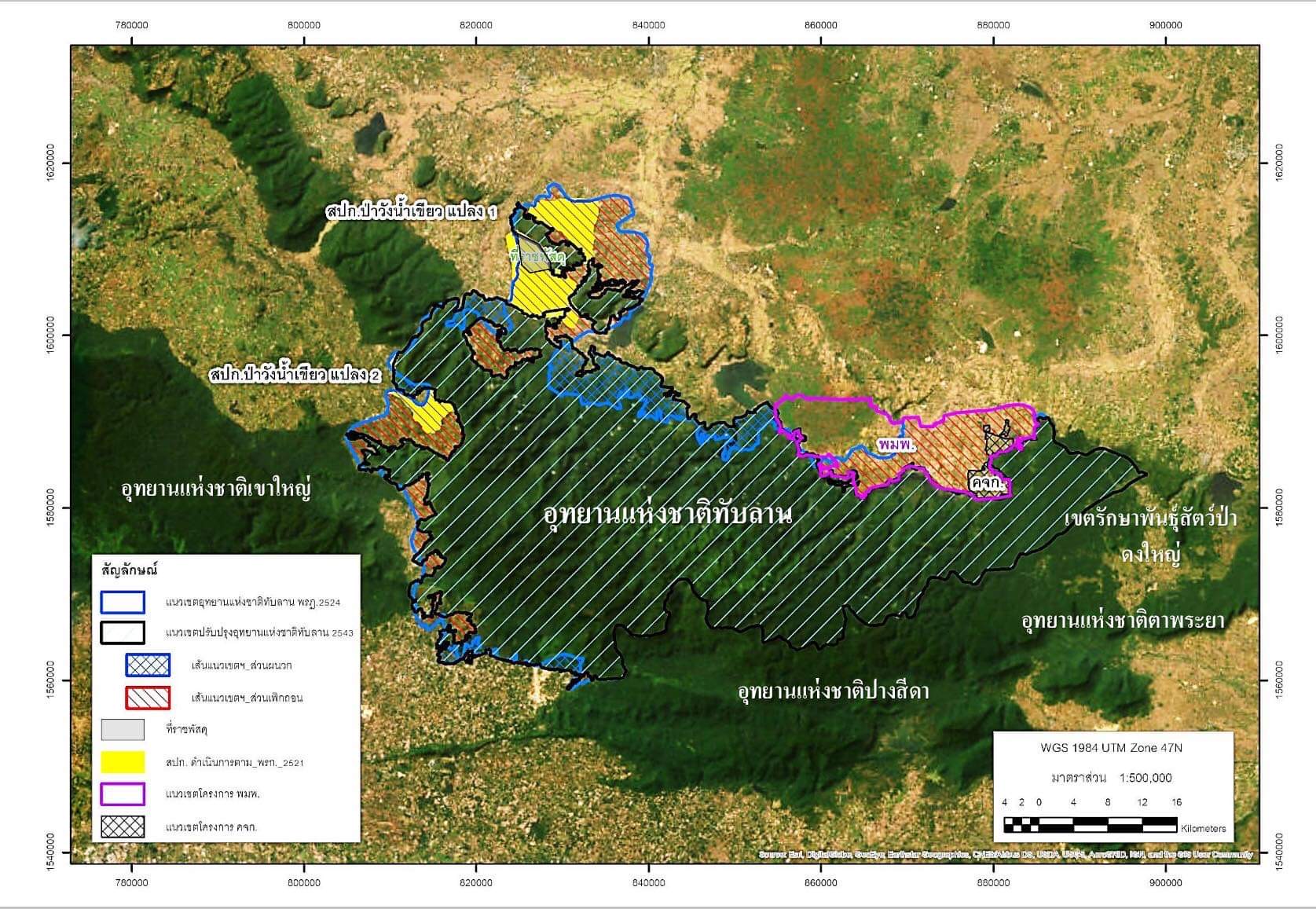Conservationists strongly oppose the NPC’s move, saying it does not play by the rules and this could rather benefit investors and forest encroachers in the area
The National Parks Committee, comprising top officials from concerned ministries and departments and some appointed experts and having the Environment Minister, Pol Gen Patcharawat Wongsuwan, acting as its Chair, held its first meeting on Thursday to consider matters relating to national parks management. Among those is the controversial boundary line and revocation of some forest areas of Thap Lan National Park, part of the Dong Phayayen-Khao Yai World Heritage Site and the country’s second-largest national park with a total area of almost 1.4 million rai.
If approved, this new boundary line could be validated and put into practice. This could prompt the national park to lose its forest area of over 200,000 rai (265,286 rai as presented to the NPC in a presentation obtained by Bangkok Tribune), the largest patch ever in the modern history of the country’s national park management, although it would be compensated with a newly included area around half of that size (86,966 rai).
To formally adjust any boundary lines of the country’s national parks or revoke or expand the national park areas, the matters must be consulted with the committee members of the NPC, who will make recommendations to the body so that they will be in line with the national policies it formulates. An environment minister will then propose the decision to the Cabinet for approval before a Royal Decree is issued to designate the adjusted areas or boundary lines.
In this meeting, the issue was not subject to consideration by the NPC’s members following the obligation under the National Parks Act BE 2562. It was placed under the agendas for “acknowledgement”, suggesting that the body had bypassed its legal obligation.


According to some sources in the meeting, the Chair tried to cut short the discussion when some committee members tried to raise the points. Among these is a far-flung implication on the boundaries and statuses of other national parks nationwide. Most of the NPC’s members, however, kept mumed over the issue.
The meeting eventually wrapped up the matter by “acknowledging” the adjustment of the boundary line of Thap Lan National Park following the Cabinet’s resolution made on March 14 last year. This was under the Prayut Chan-o-cha government. A few committee members who strongly opposed the decision asked the meeting to take note of their disagreement.
According to the March 14 Cabinet resolution, the Cabinet approved proposals over the issue prepared by the Office of National Land Policy Board (ONLPB) chaired by the PM and instructed the office as well as concerned agencies to expedite the problem-solving process.
According to the ONLPB’s proposals dated March 10, 2023, seen by Bangkok Tribune, the board approved the implementation of the BE 2543 boundary line re-delineated in 2000 in an attempt to resolve the long-standing conflict between residents and the park over their claims of overlapping areas. This was addressed as part of the body’s problem-solving framework on readjustment of state boundaries called One Map,
This boundary line has never been approved or put into use, but it was picked up in recent years as part of the solution, mainly by the Ombudsman, who had received complaints from the residents and tried to propose solutions to the government since 2018. (Read: The Ombudsman’s clarification)
The board also approved the revocation of some forest areas of the national park resulting from the new delineation of its boundary and instructed forest agencies to hand over the excluded areas to the Agricultural Land Reform Office to manage. Alro is principally tasked to allocate state land plots to the poor to make a living with modest practices, but recently the new government has just amended Alro regulations allowing Alro land plots to be transferred to others, not just the poor.
It at the same time acknowledged and endorsed the ongoing legal proceedings against forest encroachers in the conflicting area, stressing that the board’s decisions would not affect those legal processes and court proceedings.
Last but not least, the board decided to waive the June 30 BE 2541 Cabinet resolution, which addresses in its Article 2.1 that “the state shall not allocate state forest land protected under the forest laws and cabinet resolutions for agricultural land reform”. This is especially exempt for Thap Lan National Park, which is protected under the National Parks Act BE 2562.
“I think the NPC’s decision is not the way to address the issue that holds the public interest at the heart. So, I decided to reserve my vote to accept the decision,” said Sasin Chalermlarp, an NPC member and former Chairman of Seub Nakhasathien Foundation, the country’s high-profile conservation advocacy organisation.


l The new maps showing old and new boundary lines of the park as well as other areas. They were in a presentation presented to the NPC on Thursday.
The land conflict
On the north and the west of Thap Lan, different border lines of different agencies and those of residents’ properties run counter to each other. According to the ONLPB’s documents obtained by Bangkok Tribune, Thap Lan used to be a forest reserve but it was dotted with some villages and resettlements of residents before the forest was designated as the country’s 39th national park in 1981.
Two forest reserve plots, Wang Nam Khiao 1 and 2 in its north-western flank, had also been allocated for agricultural land reform a few years before the designation. Over the years, land plots in this area known widely as Wang Nam Khiao have extensively changed hands following the boom of tourism, further complicating the unsettled claims over overlapping areas.
In the early 2010s, the National Parks Department decided to swoop on a number of resorts and properties there, claiming the owners were not the original land occupants subject to the land rights verification process by the state. At the end of the operation, over 400 legal cases were taken and sent to the court.
Under the Cabinet resolution dated June 30 BE 2541, the prime policy on the issue, the state made clear that those having conflict over land rights in state forests, especially national parks, were subject to land rights verification. But that doesn’t mean that they would obtain land rights once verified. If they could prove that they lived on the land before the state forest designation, they would be allowed to live in the forests with modest living. There was also a condition imposed, stating that if the areas were considered ecologically fragile, authorities concerned could relocate them to new land plots outside and would provide them with facilities as well as land rights issuance.
The Cabinet also instructed forestry agencies to re-delineate their boundaries to make them clear. All these have become a lengthy process that finds no end. The biggest obstacle is there is no law in place to back up the implementation.
It was not until Gen Prayut Chan-o-cha entered the office through the coup in 2014. He then came up with the highly charged policy of forest-people co-existence that for the first time allowed original land occupants to live in the forests nationwide without the need to verify their rights.
The ONLPB was established to implement the policy with conditions over land uses introduced for different statuses of forests and related laws were overhauled including the National Parks Act, which was promulgated in 2019. The act came up with some key articles including Article 64 and 65 that address the implementation of the June 30 Cabinet resolution and the Prayut government’s policy, easing confrontation between forest officials and land occupants.
Seub Nakhasathien Foundation, which swiftly opposed the NPC’s decision, issued a statement yesterday expressing concerns over the decision. While rebuking the NPC that it had bypassed the proper process of the NPC, the foundation cited Article 64 and 65 as the best way out for Thap lan, revealing that the NPC had actually considered the issue twice already and agreed to pursue the implementation of the articles to solve the problem there. (Read: Seub’s statement)
If scrapping the articles and switching to the re-delineation of the park’s boundary, this would become unfair to those enjoying their rights under the articles nationwide while setting a bad example for other cases in the country, it said. More critically, the decision could rather benefit investors and forest encroachers in the conflicting area, the organisation warned.
Panudet Kerdmali, Seub’s new chairman, said the NPC needs to consider solutions for Thap Lan carefully as the land has been extensively exploited by big investors and illegitimate occupants. Its latest decision would rather set a bad example for other cases in national parks nationwide, possibly leading to a massive loss of state forestland.
“It’s a disappointment to see the agencies supposed to protect our forests manage our forest this way,” said Mr. Panudet, urging them to regain their conscience and standard of practice.

Indie • in-depth online news agency
to “bridge the gap” and “connect the dots” with critical and constructive minds on development and environmental policies in Thailand and the Mekong region; to deliver meaningful messages and create the big picture critical to public understanding and decision-making, thus truly being the public’s critical voice


